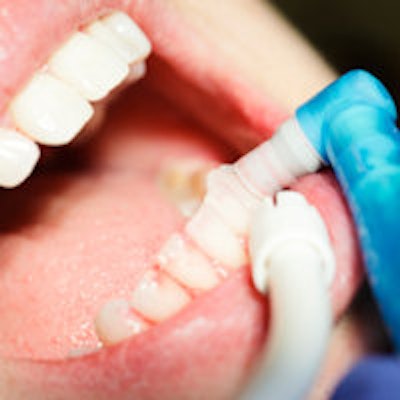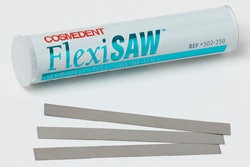
The concept of finishing and polishing dental restorations to achieve a smooth surface dates back as far as Pierre Fauchard, a French physician known as the father of modern dentistry.
Since that time, technological advances in dental materials, coupled with consumer demand for more natural-looking restorations, has resulted in an increasing array of abrasive wheels, cups, points, strips, carbides, disks, diamonds, and pastes to finish restorative materials.
 Monica F. Anderson, DDS.
Monica F. Anderson, DDS.
The result of all this choice is often a complicated procedure that takes longer than the prep and impression. The challenge for the clinician is finding cost-effective polishers and abrasives that are versatile and easy to use.
Remember tripoli and rouge? For years they were the standard when it came to finishing and polishing. Tripoli is the brown, all-purpose compound we loaded onto a cloth wheel in order to polish or remove scratches from the surface of metals. The final luster or finish was achieved with red rouge on a separate buffing wheel. The tricky part was using a light touch, keeping the restoration moving under the wheel so it didn't overheat while managing to hold on tight enough to avoid having the sacred golden bridge pulled out of your fingertips and flung into the abyss. The goal: to achieve a "mirror-like" finish so smooth that plaque would need super glue and prayer to adhere.
For years, the armamentarium for finishing and polishing was basically these two compounds and pumice. These products were used extraorally, however. Today more in-office polishing is done intraorally. Dental manufacturers like 3M ESPE, Kerr, and Shofu offer "technique kits" to facilitate chairside polishing of every material from zirconia to amalgam. These products don't seem to vary much from company to company. Most have multiple types and sizes of point or disk polishers, plus one to two mandrels.
Thus the question before us is, "Isn't there a faster, easier way?"
Goals
It is important to remember why this final step is so important, according to William Mopper, DDS, MS, who maintains a private practice in Glenview, IL, and is part owner of Cosmedent. Dr. Mopper gives several compelling reasons to properly polish and finish each restoration in an article he wrote for Inside Dentistry (March 2011, Vol.7:3, pp. 62-70):
- Reduce the likelihood of adhesion, leading to a healthier, longer-lasting restoration
- Minimize gingival irritation and surface discoloration
- Heighten marginal integrity, decreasing risk if secondary caries
- Increase reflective and refractive index for a more aesthetic smile
- Enhance the durability and wear-resistance
- Enhance patient comfort and satisfaction
These principles are ground into our memory during dental school, but those lessons tend to get misplaced on the desktop of our busy minds. Aesthetics and form mean much less to the patient if the restoration doesn't function long term. Skipping a small step at the end of the appointment can be costly in the long run.
If real teeth were perfectly flat or perfectly round, they would be easier to clean. If we can't reach 100% of the tooth surface with flexible, nylon toothbrush bristles, perhaps it's overly optimistic to think we may one day be able to finish gingival margins and occlusal fossa with a single device.
The bestselling polishing systems use a sequential series of polishers from coarse to least abrasive. Disks, diamonds, or carbide burs are used for gross contouring. Disks are flexible enough to use on the buccal/facial and line angles, but they easily damage soft tissue, so retraction is critical. Cups and points work well on the lingual and in fossa but they abrade rapidly flinging aluminum oxide particles everywhere. While the aluminum oxide is not in a form that can bind chemically with tissue, it may become an irritant if inhaled, and it is definitely messy. Interproximal finishing strips tear and are difficult to grasp.
Is it any wonder that some providers skip a few, if not all, of the 14 or so steps used in Dr. Mopper's article to contour and polish every surface of an anterior composite, despite the amazing results?
Best practices
So what are your brick-and-mortar colleagues really doing in their offices? A nonscientific survey of nine Austin, TX, area general dentists who happened to answer their telephone found that 9 out of 9 invariably use two to three grits (coarse, medium, fine) to contour and polish most restorations chairside. If the patient complains "It feels rough," they dig out the polishing paste or a silicone greenie. Cups and points enjoyed slight popularity over the more traditional pop-on flexible disk.
David Clark, DDS, a University of Washington School of Dentistry graduate, with a microscope-centered restorative practice in Tacoma, WA, has a three-step "Rock Star Finish" he recommends for composites. He demonstrates his preferred technique on YouTube. Dr. Clark warns clinicians not to overheat the tooth, which harms the pulp and bakes the composite, resulting in a chalky-looking restoration. He uses lots of water with a handpiece at low torque around 12,000 rpm to achieve an infinity edge, natural-looking restoration.
Vision USA Lab in Cherry Hill, NJ, also has an instructional video online where technician Nery Paredes demonstrates a good technique for polishing a porcelain crown to a natural luster.
Ultimately, the method and type of abrasive used should be guided by the type of material, not simply personal preference or convenience. For the best results, follow the manufacturer's or lab's recommendations.
New developments
Whether it's for acrylic, ceramic, or composite, the ideal polishing system would have the following qualities: not harmful to surrounding soft tissue, ease of use, ability to adapt to every surface of the tooth, cost-effective, and ability to polish multiple types of restorations. Additionally, it should help the clinician achieve the objectives cited by Dr. Mopper.
Perhaps in response to the demand for finishing and polishing products that are easier to use than pop-on disks, 3M Espe recently introduced the Sof-Lex spiral finishing and polishing wheels. There is nothing quite like it among the dozens of products we reviewed. Its uniqueness comes from the flexible shape that adapts to every surface of the tooth from any angle, including the interproximal (no need to switch shapes).
To visualize it, imagine a windmill made out of silicone. The "fingers" of the spiral are embedded with abrasives so every surface of the wheel can be used. The easy two-step, single-use system can be used on direct and indirect restorations: composites, resin-modified glass ionomers, temporary material, resin nanoceramics, and precious/nonprecious metals. No water cooling is needed when the pop-on spirals are used as directed, according to the manufacturer. The long-term results of this product have not been documented, but the initial reviews are favorable.
Click here to see a clinical case from start to finish by Jeff Blank, DDS, in Fort Mill, SC.
The variations between the physical properties of restorations commonly used to restore oral health preclude the possibility of a one-stone, one-step polisher despite our fondest wishes. The results of our initial goal of comparing and contrasting different polishing and finishing systems is that using the right type of abrasive and following the proper technique -- i.e., low heat -- for the type of material is much more critical for the long-term success than the label on the kit.
Nevertheless, the development of new products that decrease the chair time for patients and clinicians is beginning to spark more innovation in this section of the dental supplies catalogues.
Monica "Dr. mOe" Anderson, DDS, is a general dentist, writer, and motivational speaker in Austin, TX.



















